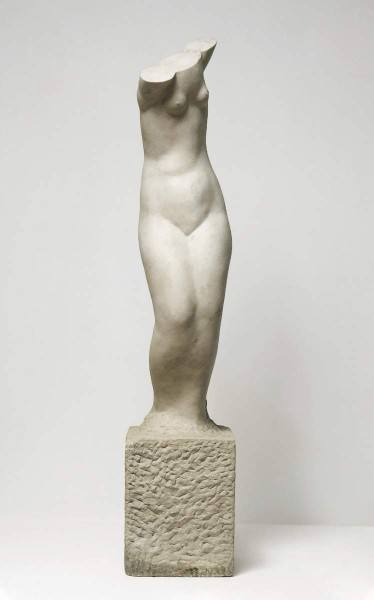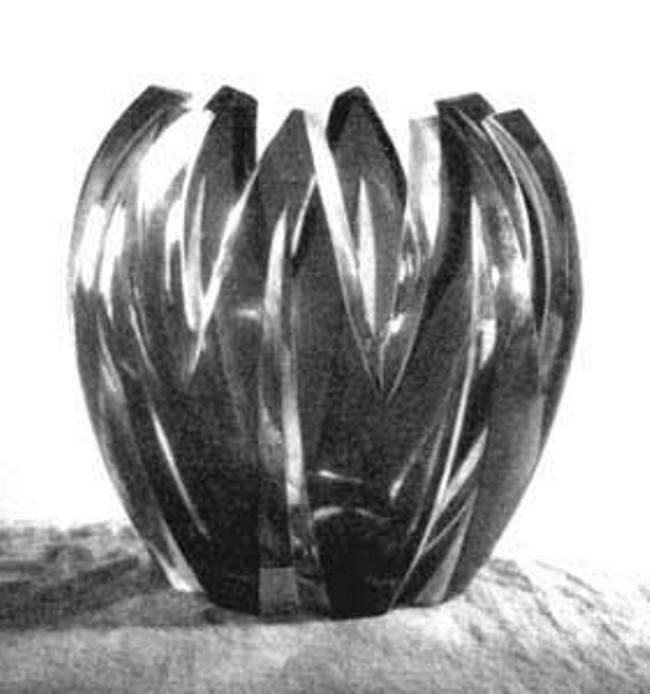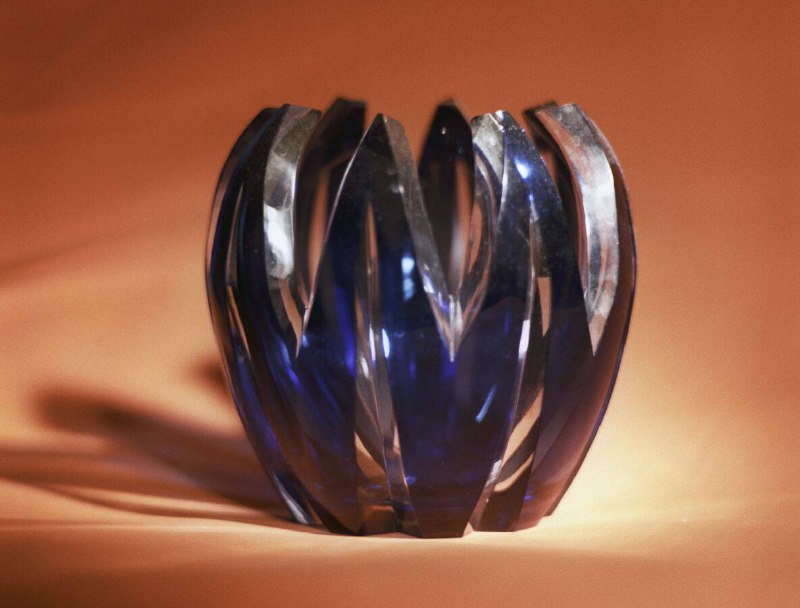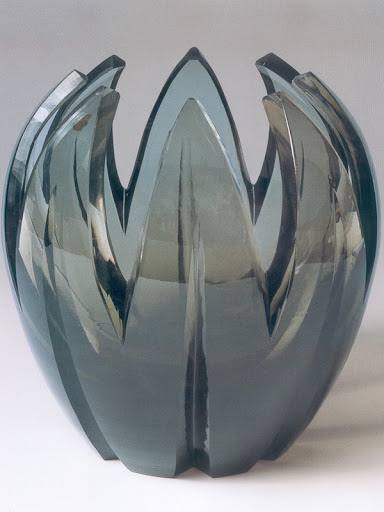Применительно к советским изделиям из стекла имя Веры Мухиной в общественном сознании прочно (хоть, вероятно, и ложно) ассоциируется с таким воплощением функционализма, как граненый стакан. Вместе с тем деятельность Веры Игнатьевны в этой области связана с возрождением в Советском Союзе именно художественного стекла. Познакомившись с творчеством муранских стеклодувов во время путешествия по Италии в 1914 г., она увлеклась этим материалом и в конце 1920-х гг. решила создать для фонтана скульптуру из льда, но этот замысел не увенчался успехом. Говоря, что самой большой любовью Веры Игнатьевны было стекло, Ольга Воронова в своей книге о художнице пишет: «Она была очарована его возможностями еще в молодости, когда любовалась витражами церкви Sainte Chapelle в Париже, изделиями стеклодувов Мурано. Потом это увлечение вспыхнуло в 1928 году, опять в Париже: увидев выставленную фирмой Лалика скульптуру из стекла, три дня ходила в магазин фирмы, купила стеклянного краба, разговаривала и с продавцами, и с мастерами, и с художниками, но секрета стеклянного литья так и не узнала».
Вылепив в 1929 г. гипсовый макет женского торса, Мухина попыталась перевести его в стекло, но ей это не удалось. В 1938—1939-х гг. она вновь обратилась к стеклу, работая на фабрике «Красный гигант»: там, помимо декоративно-прикладных изделий, она создала вазу «Астра», с которой и принято вести отсчет истории советского художественного стекла. С тех пор Мухина будет заниматься стеклоделием всю оставшуюся жизнь…
———
As far as Soviet glass is concerned, the name of Vera Mukhina has come to be closely (and falsely) associated with the famous faceted tumbler, an epitome of functionalism. That said, Mukhina was instrumental in reviving the forgotten Russian traditions of glass art. Coming across works by Murano glassblowers during her 1914 trip to Italy, Vera Mukhina was fascinated by the material and, in the late 1920s, attempted, albeit unsuccessfully, to create an ice sculpture for a fountain. In her book about Mukhina, Olga Voronova claims that glass was always Mukhina’s fondest affection: "She was enchanted by the possibilities of glass back in her youth, when she admired the stained glass of the Sainte-Chapelle in Paris and Murano glass designs. She found her interest in glass rekindled in 1928, also in Paris; after seeing a glass sculpture on display in a Lalique showroom, she spent the next three days in and out of the shop, bought a glass crab, talked to shop assistants, glassmakers, and artists but failed in having them disclose the secrets of glass casting."
In 1929, Mukhina created a plaster model of a female torso and attempted, again unsuccessfully, to cast it in glass. In 1938-1939, the artist was employed by the Krasny Gigant glassmaking factory and, among functional pieces, designed a vase, "Aster", which is commonly considered to be the starting point of Soviet glass art. Mukhina would then continue to explore the potential of glass for the remainder of her life…
Вылепив в 1929 г. гипсовый макет женского торса, Мухина попыталась перевести его в стекло, но ей это не удалось. В 1938—1939-х гг. она вновь обратилась к стеклу, работая на фабрике «Красный гигант»: там, помимо декоративно-прикладных изделий, она создала вазу «Астра», с которой и принято вести отсчет истории советского художественного стекла. С тех пор Мухина будет заниматься стеклоделием всю оставшуюся жизнь…
———
As far as Soviet glass is concerned, the name of Vera Mukhina has come to be closely (and falsely) associated with the famous faceted tumbler, an epitome of functionalism. That said, Mukhina was instrumental in reviving the forgotten Russian traditions of glass art. Coming across works by Murano glassblowers during her 1914 trip to Italy, Vera Mukhina was fascinated by the material and, in the late 1920s, attempted, albeit unsuccessfully, to create an ice sculpture for a fountain. In her book about Mukhina, Olga Voronova claims that glass was always Mukhina’s fondest affection: "She was enchanted by the possibilities of glass back in her youth, when she admired the stained glass of the Sainte-Chapelle in Paris and Murano glass designs. She found her interest in glass rekindled in 1928, also in Paris; after seeing a glass sculpture on display in a Lalique showroom, she spent the next three days in and out of the shop, bought a glass crab, talked to shop assistants, glassmakers, and artists but failed in having them disclose the secrets of glass casting."
In 1929, Mukhina created a plaster model of a female torso and attempted, again unsuccessfully, to cast it in glass. In 1938-1939, the artist was employed by the Krasny Gigant glassmaking factory and, among functional pieces, designed a vase, "Aster", which is commonly considered to be the starting point of Soviet glass art. Mukhina would then continue to explore the potential of glass for the remainder of her life…
4❤41🔥12👍11😁1
group-telegram.com/midcenturymodern/16849
Create:
Last Update:
Last Update:
Применительно к советским изделиям из стекла имя Веры Мухиной в общественном сознании прочно (хоть, вероятно, и ложно) ассоциируется с таким воплощением функционализма, как граненый стакан. Вместе с тем деятельность Веры Игнатьевны в этой области связана с возрождением в Советском Союзе именно художественного стекла. Познакомившись с творчеством муранских стеклодувов во время путешествия по Италии в 1914 г., она увлеклась этим материалом и в конце 1920-х гг. решила создать для фонтана скульптуру из льда, но этот замысел не увенчался успехом. Говоря, что самой большой любовью Веры Игнатьевны было стекло, Ольга Воронова в своей книге о художнице пишет: «Она была очарована его возможностями еще в молодости, когда любовалась витражами церкви Sainte Chapelle в Париже, изделиями стеклодувов Мурано. Потом это увлечение вспыхнуло в 1928 году, опять в Париже: увидев выставленную фирмой Лалика скульптуру из стекла, три дня ходила в магазин фирмы, купила стеклянного краба, разговаривала и с продавцами, и с мастерами, и с художниками, но секрета стеклянного литья так и не узнала».
Вылепив в 1929 г. гипсовый макет женского торса, Мухина попыталась перевести его в стекло, но ей это не удалось. В 1938—1939-х гг. она вновь обратилась к стеклу, работая на фабрике «Красный гигант»: там, помимо декоративно-прикладных изделий, она создала вазу «Астра», с которой и принято вести отсчет истории советского художественного стекла. С тех пор Мухина будет заниматься стеклоделием всю оставшуюся жизнь…
———
As far as Soviet glass is concerned, the name of Vera Mukhina has come to be closely (and falsely) associated with the famous faceted tumbler, an epitome of functionalism. That said, Mukhina was instrumental in reviving the forgotten Russian traditions of glass art. Coming across works by Murano glassblowers during her 1914 trip to Italy, Vera Mukhina was fascinated by the material and, in the late 1920s, attempted, albeit unsuccessfully, to create an ice sculpture for a fountain. In her book about Mukhina, Olga Voronova claims that glass was always Mukhina’s fondest affection: "She was enchanted by the possibilities of glass back in her youth, when she admired the stained glass of the Sainte-Chapelle in Paris and Murano glass designs. She found her interest in glass rekindled in 1928, also in Paris; after seeing a glass sculpture on display in a Lalique showroom, she spent the next three days in and out of the shop, bought a glass crab, talked to shop assistants, glassmakers, and artists but failed in having them disclose the secrets of glass casting."
In 1929, Mukhina created a plaster model of a female torso and attempted, again unsuccessfully, to cast it in glass. In 1938-1939, the artist was employed by the Krasny Gigant glassmaking factory and, among functional pieces, designed a vase, "Aster", which is commonly considered to be the starting point of Soviet glass art. Mukhina would then continue to explore the potential of glass for the remainder of her life…
Вылепив в 1929 г. гипсовый макет женского торса, Мухина попыталась перевести его в стекло, но ей это не удалось. В 1938—1939-х гг. она вновь обратилась к стеклу, работая на фабрике «Красный гигант»: там, помимо декоративно-прикладных изделий, она создала вазу «Астра», с которой и принято вести отсчет истории советского художественного стекла. С тех пор Мухина будет заниматься стеклоделием всю оставшуюся жизнь…
———
As far as Soviet glass is concerned, the name of Vera Mukhina has come to be closely (and falsely) associated with the famous faceted tumbler, an epitome of functionalism. That said, Mukhina was instrumental in reviving the forgotten Russian traditions of glass art. Coming across works by Murano glassblowers during her 1914 trip to Italy, Vera Mukhina was fascinated by the material and, in the late 1920s, attempted, albeit unsuccessfully, to create an ice sculpture for a fountain. In her book about Mukhina, Olga Voronova claims that glass was always Mukhina’s fondest affection: "She was enchanted by the possibilities of glass back in her youth, when she admired the stained glass of the Sainte-Chapelle in Paris and Murano glass designs. She found her interest in glass rekindled in 1928, also in Paris; after seeing a glass sculpture on display in a Lalique showroom, she spent the next three days in and out of the shop, bought a glass crab, talked to shop assistants, glassmakers, and artists but failed in having them disclose the secrets of glass casting."
In 1929, Mukhina created a plaster model of a female torso and attempted, again unsuccessfully, to cast it in glass. In 1938-1939, the artist was employed by the Krasny Gigant glassmaking factory and, among functional pieces, designed a vase, "Aster", which is commonly considered to be the starting point of Soviet glass art. Mukhina would then continue to explore the potential of glass for the remainder of her life…
BY Mid-Century, More Than




Share with your friend now:
group-telegram.com/midcenturymodern/16849
